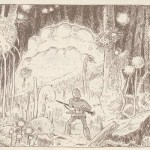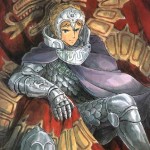“. . . In this harsh world of ours, the sparrow must live like a hawk if he is to fly at all.” – King Jhil, p. 24
In this installment, I’ll be covering volume 1 of the Nausicaä of the Valley of the Wind manga. (Nota bene: I’m using VIZ’s Editor’s Choice edition, which is roughly analogous to the Japanese collected volumes.)
What Happens
One thousand years after the fall of industrial civilization following the Seven Days of Fire, civilization has collapsed into two warring factions: the inbred Torumekian Empire and the theocratic Dorok Principalities. The Sea of Corruption, a poisonous forest of giant fungus guarded by enormous insects called Ohmu, grows over the land. At the edge of the forest lies the Valley of the Wind, kept safe from the forest’s miasma by ocean breezes.
Nausicaä is the princess of the Valley of the Wind, daughter of King Jhil, and a windrider, adept at riding on her mehve glider. After a brief sojourn into the nearby Sea of Corruption, Nausicaä rescues Lord Yupa, a wandering swordsman, from an Ohmu ambush. Yupa is welcomed back to the Valley of the Wind after a long absence. King Jhil tells Yupa that Nausicaä will be taking on the responsibilities of valley chieftain in his place. This includes going to war for Torumekia, as the valley is bound by an ancient treaty in return for their sovereignty. Yupa laments that there are fewer people living in the valley every year he returns.
Nausicaä and her uncle Mito fly the valley’s gunship, a relic of a past age, the next day. They find a brig transport from the neighboring kingdom of Pejitei beset by angry insects, and despite Nausicaä’s help, the ship crashes. Nausicaä finds a sole survivior: Rastel, the princess of Pejitei. Rastel gives Nausicaä a stone intended for her twin brother Asbel. She tells Nausicaä that Torumekian forces have destroyed Pejitei for the stone, which is the key to creating a God Warrior, one of the giant beings that destroyed the Earth in the Seven Days of Fire.
After Nausicaä and Mito return to the valley, the Torumekian force that attacked Pejitei lands in the valley. Nausicaä commands their forces to leave the valley; when they refuse, Nausicaä goes into a rage, killing a soldier before Yupa intervenes. The leader of the Torumekian forces, princess Kushana, introduces herself and says that she and Nausicaä will meet on the field of battle soon as allies.
After departing the valley, Kushana laments being commanded away from the main fighting with the Dorok empire, and hatches a plan to return to the main front over the Sea of Corruption. Kushana’s new royal attache, Kurotowa, survives an assassination attempt planned by her guard. Kushana realizes that Kurotowa will be no pushover.
Meanwhile, Nausicaä prepares to depart for the war front. Yupa finds her that night in an underground laboratory, where she has been growing fungus from the Sea of Corruption; she tells Yupa that the fungus isn’t poisonous when grown in clean water and air. Yupa realizes that the forest is actually cleansing the land, not polluting it.
Nausicaä, Mito, and a small retinue of old men join Kushana’s forces, including other small, allied kingdoms, as they fly over the Sea of Corruption for the war front. En route, their forces are ambushed by a small gunship from Pejitei, piloted by Asbel, Rastel’s twin brother. After Nausicaä’s party crashes in the forest, they encounter a herd of Ohmu, who are heading south for another forest that needs its protection.
Nausicaä takes her glider and leaves her party behind to rescue Asbel from rampaging insects. They escape to a portion of the forest free from the miasma. Nausicaä realizes the secret of the forest: the fungus trees, after cleaning the poison from the earth, crystallize into sand and collapse, leaving behind purified land. She gives Asbel the stone that Rastel gave her before she died. Together with Asbel, they depart the forest on her glider.
My Thoughts

What a memorable opening. In the opening pages, we see a glider sail over a forest of fungi piloted by a young woman. After she lands and enters the forest, she finds an enormous insect molting, which she harvests for use back home. As she pries off a lense the size of a hula hoop, white spores fall like snow around her. She remarks that if she didn’t have her mask on, the air inside would kill her within minutes. Soon, she rescues her friend Yupa from an insect ambush, then tames a squirrelfox she names Teto.
From the start, Nausicaä is portrayed as a (com-)passionate and inquisitive young woman, concerned with the fate of the forest and the insects who guard it. She has little concern for superstition, casting aside a magical mail shirt woven by the women of the valley for her protection to save weight, and pursues knowledge of the natural world. Few other heroines run their own personal laboratory, scavenge scientific specimens in a dangerous environment, ride the wind on a powered glider, and still know how to repair a broken windmill.
Yet Nausicaä is impulsive, and her passion can turn to rage if her kingdom is threatened. This isn’t yet the Nausicaä that would save a dying baby Ohmu or lead a charge to save a platoon of soldiers without firing a single shot. Her trademark pacifism has yet to be learned.
She also displays a mild telepathy, which she uses to read the thoughts of the animals (including the Ohmu) as well as, in intense circumstances, other humans. Her powers are implied to come from an early childhood encounter with a baby Ohmu, having looked into the “cold heart” of the insects at an early age.

The more ambiguous Princess Kushana of Torumekia, ruthless and stoic, is every bit Nausicaä’s foil. She enters the story dramatically, landing in the valley of the wind and demanding Nausicaä give up the stone. (Kushana employs worm handlers for this, a Fremen-like culture who wrangle large grubs; Nausicaä shakes off the encroaching worms with her telepathic powers.) She values the loyalty of her soldiers, but cares for little else. She knows her two brothers are scheming against her to prevent her taking the throne after the current Vai Emperor dies. Her attempted dispatching of Kurotowa, himself a magnificent bastard, shows just how ruthless she can be.
Nausicaä is surrounded by elderly men, a fact of the dwindling population of the Valley of the Wind. King Jhil, her father, is bedridden, dying from the poisons of the Sea of Corruption that eventually kill those who live in the Valley of the Wind. Uncle Mito is her attendant, a grumpy old man missing an eye, a snarky Odin. Yupa, itinerant swordsman, is a mystery, and will remain so for the rest of the series.
The two other characters her age in this volume are Rastel and Asbel, twins and heirs to the now-ruined kingdom of Pejitei. Rastel doesn’t live long enough to make much of her. Asbel shares her enthusiasm, but Nausicaä is far wiser, knowing not to enrage the Ohmu having crashed in the Sea of Corruption.
We’re left with one big question at the end of this volume, one which will have big consequences throughout the series: why are the Ohmu herds migrating south into Dorok? Nausicaä’s intends to find out, but for now she and Asbel have to make it out of the Sea of Corruption alive, which won’t be easy.
Nausicaä and Kushana: Contrasting Martial Archetypes
In his thesis Goddesses of Water and Sky, Daniel Nienhuis describes the older sister/younger sister pairs of characters Miyazaki employs in his work. The younger “sister” is typically idealistic and more impulsive, the older “sister” rational and responsible, if not outright cynical. He argues that the princesses Nausicaä and Kushana fit the younger and older sister roles. I would argue that their visual depiction uses contrasting female martial archetypes as well to distinguish them.
Miyazaki discusses princess Nausicaä’s influences in an essay included in volume 1, which was also printed in Animaze during the original print run. He cites the character Nausicaä from The Odyssey, the compassionate daughter who saves Odysseus, and the Japanese short story “The Lady Who Loved Insects,” about a court princess who ignores social conventions and studies insects.

There’s another, more western influence as well: that of Joan of Arc, the peasant girl who claimed divine guidance as she led an army to several victories in France before being burned at the stake as a heretic in 1431. Nausicaä is depicted as humble and unassuming, guided by conscience, and so charismatic as to gain a number of followers. In later volumes, she is captured by a religious authority and tried. Even common depictions of Joan of Arc resemble how Miyazaki draws Nausicaä.

Kushana, Nausicaä’s shadow archetype, has a more regal influence: Queen Elizabeth I of England. Both women were born to obese, tyrannical kings, and overcame court intrigue to survive. Tellingly, Kushana has no suitors (with a brief, but notable exception, around volume 6); Elizabeth never married. Even their visual depictions share some similarities.
Of Rabbits and Smeerps

Squirrelfoxes, horseclaws, and other fictional animals inhabit Nausicaä’s world alongside seemingly normal humans. (How they got there is explained in volume 7.) There are no “real” creatures depicted in the story, although the mundane use of “sparrow” and other recognizable names are used from time to time.
As opposed to “calling a rabbit a smeerp” (from the Turkey City Lexacon), this device is “calling a smeerp a rabbit,” or using a mundane name for an extraordinary object or creature. The insects are given more elaborate names such as Ohmu and Royal Yanma, but otherwise Miyazaki prefers to call his smeerps “rabbits.” He could have chosen more unusual names, given the visual nature of this story, but because there are no real-life analogues — no “horse” to compare to a “horseclaw” — his naming convention makes sense.
This and That
Nausicaa.net provides a cheat sheet for notable character, places, events, and creatures in the manga.
I’ve sourced a lot of the images for this article; when I get a scanner in the next couple of weeks I’ll be able to embed better samples.
Next time, I’ll cover our heroine’s attempt to quell an Ohmu stampede in volume 2.
